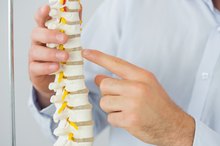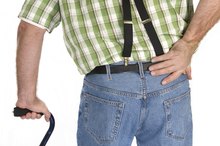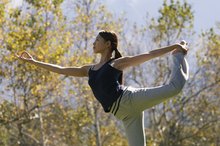Signs & Symptoms of a Tight Trapezius Muscle
The trapezius is a large muscle located on the back of your neck and shoulders. It extends from the upper neck down through the vertebrae in the middle of your back. This muscle moves the shoulder blades and supports the arms. Lack of flexibility in the traps will cause underlying problems in other areas. The areas most effected by trapezius tightness are the arms, shoulders and lower spine.
Poor Postural Alignment
Tight traps prevent your shoulders from being in their proper position. Your shoulders should be situated about even with your ears, not in front of your ears. Because trapezius tightness makes it difficult to bring your shoulder blades close to your spine, it pushes the shoulders and upper spine excessively forward. Repetitive poor posture can lead to kyphosis of the spine, an unnatural forward curvature of the upper spine. This excessive spinal curvature is extremely hard to unlearn.
- Tight traps prevent your shoulders from being in their proper position.
- Because trapezius tightness makes it difficult to bring your shoulder blades close to your spine, it pushes the shoulders and upper spine excessively forward.
Upper Back Pain
Vitamins for Back Pain
Learn More
Another symptom of trapezius tightness is radiating upper back pain. When a muscle area is tight, it becomes very constricted. This constriction makes it hard for the upper back to provide optimal support. Lack of muscle support from the traps could lead to discomfort that runs down through the length of the thoracic spine or up the neck.
- Another symptom of trapezius tightness is radiating upper back pain.
- This constriction makes it hard for the upper back to provide optimal support.
Lower Back Fatigue
Tightness keeps the trapezius from fulfilling its role as a major stabilizer in muscle movements. Head turns and pulling motions require high amounts of trapezius stability. Because tightness in the traps seriously hinders its ability to move and contract, the lower spine has to pick up the slack during upper body activities. The lumbar or lower spine is mostly designed for basic stabilization, not for heavy muscle recruitment. Overexertion of the spine leads to fatigue and possibly injury.
- Tightness keeps the trapezius from fulfilling its role as a major stabilizer in muscle movements.
- The lumbar or lower spine is mostly designed for basic stabilization, not for heavy muscle recruitment.
Lack of Arm and Shoulder Mobility
Can a Pinched Nerve Cause Dizziness?
Learn More
One of the major functions of the trapezius is arm support. Lack of trap flexibility impedes support of both of your arms, which threatens support of your shoulders as well. With tight traps, the limited support in the arms and shoulders inhibits mobility in both areas, making side-to-side and overhead arm maneuvers difficult.
Related Articles
References
- Ourieff J, Agarwal A. Anatomy, Back, Trapezius. [Updated 2018 Dec 6]. In: StatPearls [Internet]. Treasure Island (FL): StatPearls Publishing; 2019 Jan-. Updated December 6, 2018.
- Terson de paleville DG, Mckay WB, Folz RJ, Ovechkin AV. Respiratory motor control disrupted by spinal cord injury: mechanisms, evaluation, and restoration. Transl Stroke Res. 2011;2(4):463-73. doi:10.1007/s12975-011-0114-0
- Kamali F, Sinaei E, Morovati M. Comparison of Upper Trapezius and Infraspinatus Myofascial Trigger Point Therapy by Dry Needling in Overhead Athletes With Unilateral Shoulder Impingement Syndrome. J Sport Rehabil. 2019;28(3):243-249. doi:10.1123/jsr.2017-0207
- Kamali, F. Comparison of Upper Trapezius and Infraspinatus Myofascial Trigger Point Therapy by Dry Needling in Overhead Athletes With Unilateral Shoulder Impingement Syndrome. J Sport Rehabil. Jan 2018.
- Kendall, Florence, McCreary, Elizabeth Kendall, Provance, Patricia Geise. Muscles Testing and Function 4th ed. Williams and Wilkins. Baltimore, Maryland, 1993.
Writer Bio
Based in New York, John Tavolacci has been a leading exercise physiologist for over 14 years. His resume includes stints in cardiac rehab, sports conditioning, physical therapy and corporate wellness. He is a certified health/fitness instructor and a certified strength and conditioning specialist. Tavolacci also holds a master's degree in exercise physiology from Queens College.








